非谓语动词时态和语态句法功能一览表,简洁,明细,容量大
- 格式:doc
- 大小:84.50 KB
- 文档页数:2
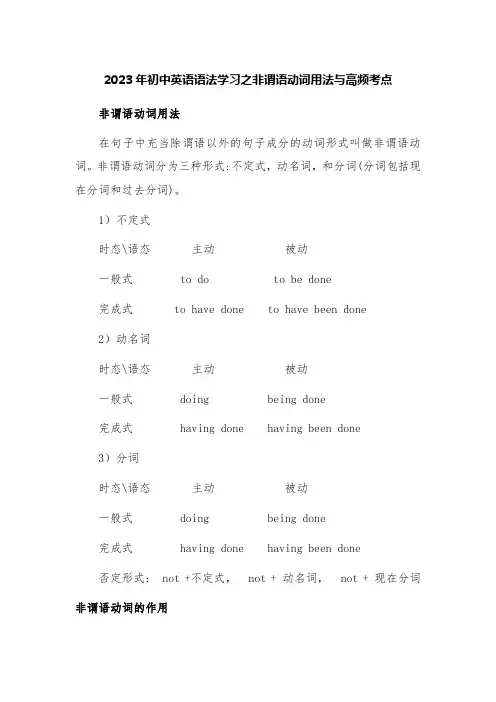
2023年初中英语语法学习之非谓语动词用法与高频考点非谓语动词用法在句子中充当除谓语以外的句子成分的动词形式叫做非谓语动词。
非谓语动词分为三种形式:不定式,动名词,和分词(分词包括现在分词和过去分词)。
1)不定式时态\语态主动被动一般式to do to be done完成式 to have done to have been done2)动名词时态\语态主动被动一般式doing being done完成式having done having been done3)分词时态\语态主动被动一般式doing being done完成式having done having been done否定形式: not +不定式,not + 动名词,not + 现在分词非谓语动词的作用非谓语动词除去不能做谓语之外,其它所有成分都可以做。
具体如下。
1. 不定式:做主语、宾语、表语、定语、状语和补语。
To learn a foreign language is difficult .(作主语)学会一门外语是很难的。
It’s easy to see their aunt.(作真正主语,it做形式主语)很容易见到他们的姑姑。
Tom wanted to have a cup of beer.(作宾语)汤姆想要喝杯啤酒。
His wish is to be a driver.(作表语)他的愿望是当一名司机。
I have nothing to say.(作定语)我没有什么可说的。
The teacher told us to do morning exercises . (作宾语补足语)老师让我们做早操。
They went to see their aunt. (目的状语)他们去见他们的姑姑。
2. 动名词:做主语、宾语、表语、定语和补语。
Learning English is very difficult .(作主语)学英语非常困难。
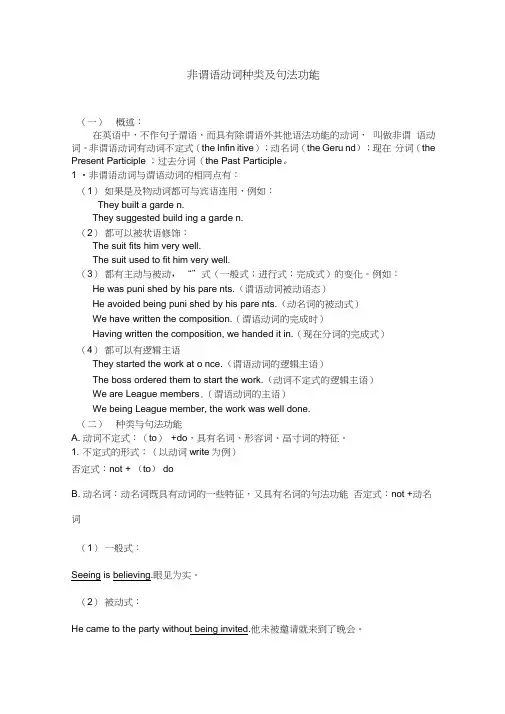
非谓语动词种类及句法功能(一)概述:在英语中,不作句子谓语,而具有除谓语外其他语法功能的动词,叫做非谓语动词。
非谓语动词有动词不定式(the Infin itive);动名词(the Geru nd);现在分词(the Present Participle ;过去分词(the Past Participle。
1 •非谓语动词与谓语动词的相同点有:(1)如果是及物动词都可与宾语连用,例如:They built a garde n.They suggested build ing a garde n.(2)都可以被状语修饰:The suit fits him very well.The suit used to fit him very well.(3)都有主动与被动,“”式(一般式;进行式;完成式)的变化。
例如:He was puni shed by his pare nts.(谓语动词被动语态)He avoided being puni shed by his pare nts.(动名词的被动式)We have written the composition.(谓语动词的完成时)Having written the composition, we handed it in.(现在分词的完成式)(4)都可以有逻辑主语They started the work at o nce.(谓语动词的逻辑主语)The boss ordered them to start the work.(动词不定式的逻辑主语)We are League members.(谓语动词的主语)We being League member, the work was well done.(二)种类与句法功能A. 动词不定式:(to)+do,具有名词、形容词、畐寸词的特征。
1. 不定式的形式:(以动词write为例)否定式:not + (to) doB. 动名词:动名词既具有动词的一些特征,又具有名词的句法功能否定式:not +动名词(1)一般式:Seeing is believing.眼见为实。

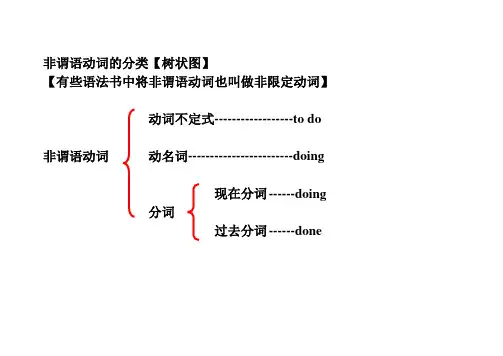
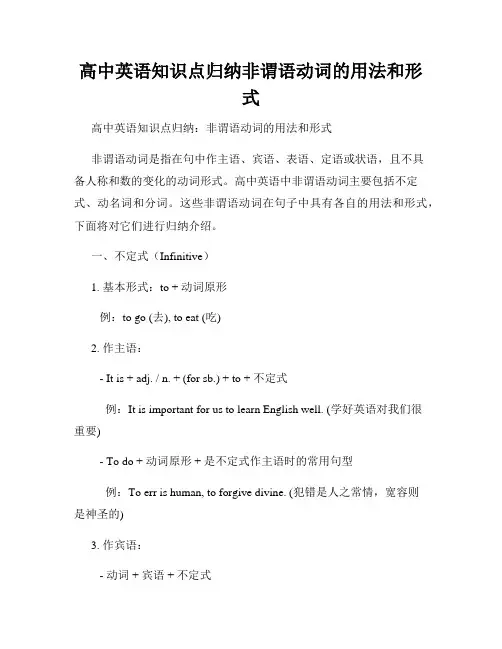
高中英语知识点归纳非谓语动词的用法和形式高中英语知识点归纳:非谓语动词的用法和形式非谓语动词是指在句中作主语、宾语、表语、定语或状语,且不具备人称和数的变化的动词形式。
高中英语中非谓语动词主要包括不定式、动名词和分词。
这些非谓语动词在句子中具有各自的用法和形式,下面将对它们进行归纳介绍。
一、不定式(Infinitive)1. 基本形式:to + 动词原形例:to go (去), to eat (吃)2. 作主语:- It is + adj. / n. + (for sb.) + to + 不定式例:It is important for us to learn English well. (学好英语对我们很重要)- To do + 动词原形 + 是不定式作主语时的常用句型例:To err is human, to forgive divine. (犯错是人之常情,宽容则是神圣的)3. 作宾语:- 动词 + 宾语 + 不定式例:I want to study abroad. (我想出国留学)- 动词 + 宾语 + 不定式的几个常见动词:want, plan, hope, expect, decide, try, learn, ask, tell, invite, encourage, order, allow, forbid等。
4. 作表语:- 主语 + be + adj. + 不定式例:His dream is to become a doctor. (他的梦想是成为一名医生)5. 作定语:- 不定式作定语通常放在被修饰的名词之后,常用逗号和其他修饰成分隔开例:He is a person, ready to help others. (他是一个乐于助人的人)6. 作状语:- 表目的:in order to / so as to + 动词原形例:He studies hard in order to pass the exam. (他努力学习为了通过考试)- 表结果:too + adj. / adv. + (for sb.) + to + 动词原形例:The box is too heavy for me to lift. (这个盒子对我来说太重,搬不动)二、动名词(Gerund)1. 基本形式:动词原形 + -ing例:going (去), eating (吃)2. 作主语:- 动名词作主语时,通常用单数形式例:Playing football is his hobby. (踢足球是他的爱好)3. 作宾语:- 介词 + 动名词例:I am good at playing chess. (我擅长下棋)4. 作表语:- 主语 + be + 动名词例:His hobby is collecting stamps. (他的爱好是收集邮票)5. 作定语:- 动名词作定语通常放在被修饰的名词之前例:I saw a running dog in the park. (我在公园见到一只奔跑的狗)6. 作状语:- 表目的:动名词前面加介词for或动名词短语例:He practices playing the piano every day for improvement. (他每天练习弹钢琴以提高)三、分词(Participle)分词根据用法和形式的不同,分为现在分词和过去分词。
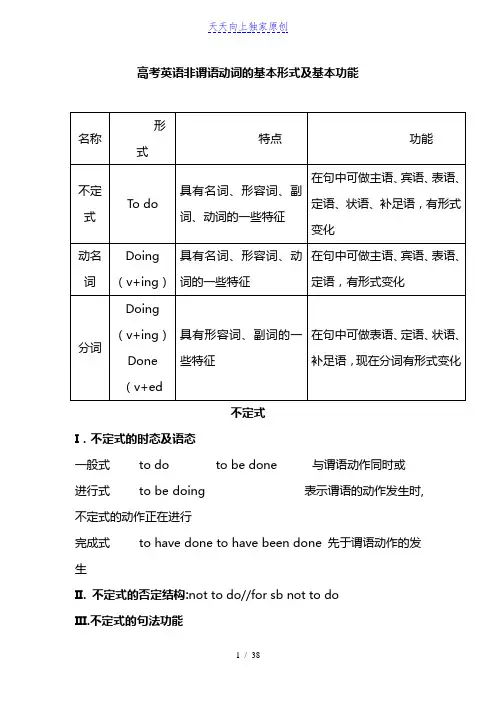
高考英语非谓语动词的基本形式及基本功能不定式I.不定式的时态及语态一般式to do to be done 与谓语动作同时或进行式to be doing 表示谓语的动作发生时,不定式的动作正在进行完成式to have done to have been done 先于谓语动作的发生II. 不定式的否定结构:not to do//for sb not to doIII.不定式的句法功能1.主语To see is to believe.It is not easy to learn a language well.(不定式作主语时往往用it做形式主语)动词不定式做主语的常用句型It is +adj/n +to do sthIt is +adj +of/for sb to do sthIt takes sb sometime to doKind, clever, wise, nice 形容词既表示人物特征,Foolish, stupid, honest, 又表示说话人对不定式Right, correct, wrong, +of sb 动作的评价;形容词与Rude, cruel, careless, 介词宾语成主谓关系Lazy, selfish, horrible如:It‘s kind of you to help me。
=You are kind to help me。
Easy, hard, difficultPossible, necessary, 形容词说明不定式行为的Important, essential, +for sb 性质,与介词宾语不具有Interesting, unusual,……….. 主谓关系Interesting, natural如: It’s easy for me to learn English.=To learn English is easy for me.2..表语My job is to attend the children.(不定式作表语时,如在它前出现了do, did, does时,不定式符号to 可省掉,例:what you have to do this afternoon is (to) look after the sick child.)3.定语I have a lot of work to do. //She has no place to go.4.宾语I hope to go to Dalian again.I find it interesting to play the violin.(不定式作宾语时,如果还带有宾语补足语,往往用it作形式宾语,而把真正的宾语放到后面)5.宾补The teacher told us to clean the windows.I noticed the boy go into the shop.注: feel, listen to, hear, see, watch, notice, observe, look at, make, let ,have等使役动词后宾语补足语时,不定式符号to要省略,但这些句子变为被动语态时,就必须带to 符号. 例:I often hear him sing this song.He is often heard to sing this song.6.状语表示目的: I got up early to(in order to/ so as to)catch the early bus.To/In order to pass the exam, he worked hard.(so as to不能用于句首)表示原因: We were excited to hear the news.I am sorry to have hurt you.表示结果: I hurried home to find Mary waiting for me.(不定式作结果状语时,常表示未预料之中的事,可在不定式前加only)表示条件: To look at him, you would like him.修饰全句(独立成分) To tell you the truth, I have got no money about me.To be honest, I know nothing about it.不定式做状语的常用句型注:1) too + pleased/kind/ willing/ glad/eager/anxious…+to do 的结构即不表示结果,也无否定含义.I shall be only too pleased to get home(=I shall be very pleased to get home,)It’s too kind of you to have told me that(=You are very kind to have told me that.)使用不定式时要注意以下几点:1.在作tell, show, understand, explain, teach, advise, discuss等词的宾语时, 前面常带疑问词(how, when ,where,what , who…)2.不定式在介词but后面时,如but前有do 的各种形式,那么but 后的to要省略,否则就要带to.另外在cannot but, can’t choose but, can’t help but后面的to也省略.We could do nothing but waitWe had nothing to do but wait.We had no choice but to wait.3.作定语的不定式是不及物动词时,不定式后须有相应的介词,但如果所修饰的名词是time, place, way时,不定式后的介词习惯上省略. We have to find a room to live in.Please give me a knife to cut with.He had no money and no place to live.We found a way to solve the problems.4. something is easy to do 类似句型中不定式不用被动形式.There is something to do/There is something to be done0 5.what, when. Where, how. who…+to do 可在句中做主语\宾语\表语.动名词I.形式:V+ing一般式doing being done 与谓语动作同时发生完成式Having done having been done 在谓语动作之前否定结构Not doing/ not having doneII.动名词的句法功能1.主语: (表示一般或抽象的多次性动作)Smoking is a bad habit.It is no use arguing with him.2.表语(说明主语的具体内容)Her job is building houses.3.宾语He is fond of playing football.//Would you mind my closing the door?4.定语(说明被修饰词的用途)reading materials, swimming pool, waiting room5.同位语His job, building a house, is almost done.使用动名词时要注意的几点1.下列句型常用动名词no use/ goodIt is/was not any use/good + doingof little/gooduseless2.下列动词或动词词组后用动名词allow, advise, admit, appreciate, avoid, can’t help, consider, delay,dislike, deny, enjoy, escape, excuse, finish, fancy,, favour, imagine, keep, mind, miss, postphone, practise, risk, suggest, be used to, can’t help ,give up, go on , give one’s life to ,feel like, keep on, insist on, object to,turn to, lead to, look forward to, stick to , devote to, get down to3.既可后跟不定式,又可跟动名词做宾语的动词do 记住去做rememberdoing 记得做过to do 忘了去做forgetdoing 忘了做过to do 对尚未做的事感到遗憾regretdoing// to have done 对做过的事感到遗憾,后悔to do 打算去做meandoing 意味着to do 努力做trydoing 试着做to do 学会learndoing 学做doing 泛指love/like/hate/preferto do 特指具体的动作to do 停下来开始去做某事stopdoing 停止正在做的事(to) do 不能帮助做can’t helpdoing 情不自禁的做to do 接着做go ondoing 继续不断地做,继续做同一件事to be doneneed/require/ want/ deserve 结构不同,意思一样doing sth4.start/begin doing/to do 基本可互换但下列情况用不定式1)主语指物时2)后面跟表示感情\思想\和意念的动词时3)begin/start本身是进行时态时It started to rain.She is beginning to cook dinner.She began to realize his mistakes.5.动名词的复合结构my, your, our…me, you, us….. +doingmy father, tom….My father’s, Tom’s动名词的复合结构作主语时,动名词的复合结构只能用one’s +doingWould you mind me/ my/ LI Ming/ Li Ming’s opening the window?Mary’s crying made her mother angry.His losing the game made us very disappointed.分词分词分现在分词和过去分词其否定结构为not+ 分词,分词在句中意义同形容词和副词,可以承担形容词和副词在句中所承担的句子成分.I.分词的时态和语态一般式doing being done现在分词分词完成式having done having been done过去分词done2.分词的句法功能1)定语(单个分词作定语时放在所修饰词的前面,分词短语作定语时放在所修饰词的后面)This is an amusing story.The excited people rushed into the building.The boy standing at the door is my cousin.The letter posted yesterday will soon reach him.2)表语The news was inspiring.The glass is broken.We were excited at the news.3)宾补I heard a girl crying next door.I am sorry to have kept you waiting for so long.I found my key lost.4)状语Being a student, I must study hard. 原因While crossing the street, be careful. 时间Given a chance, I can surprise the world.(条件)Having been told many times, he still repeated the same mistake.让步The teacher entered the lab, followed by the students. 伴随状语His parents died, leaving him an orphan. 时间(分词作状语表示结果时常表示意料中的事)注:分词作状语可表示时间,原因,结果,行为方式\伴随状语等,分词作状语时前后主语必须一致,如以上各句.如前后主语不一致必须用独立主格结构即: 名词或代词+分词(doing/done)/不定式/介词/短语/形容词/副词Weather permitting, we’ll go sightseeing.条件It being Sunday, we went climbing.原因Work finished, the boy went out to play.时间He lay on his back, his eyes looking up at he sky.伴随The exam to be held tomorrow, I can’t go to the cinema tonight.原因School over, We went home.时间He came, his hands red with cold.伴随另外with 的复合结构也是一种独立主格结构.非谓语动词间的比较1.非谓语动词在句子中的作用2.不定式、动名词作主语的区别3.非谓语动词做主语\表语的区别一般可以互换,但如详细地加以区分的话,动名词表示普遍的习惯性的或抽象的动作,不定式则表示某一次具体的动作.I like swimming, but I don’t like too swim this afternoon. Her job is giving piano lessons to children, but this Sunday her job is to teach the children how to dance.注:现在分词表示”令人…”多修饰物,过去分词表示”感到…”,多修饰人.We were interested in an interesting story.4.非谓语动词做定语的区别注:现在分词的被动式(being done) 做定语时现在不定式的被动式(to be done) 表示的被动将来及物动词的过去分词(done 动作发生在过去being used in our school now.This is the book to be used in our school next year.used in our school last year5.不定式,分词做宾语补语时的区别现在分词表示动作正在进行,不定式表示动作的整个过程或动作的反复多次.注:感官动词feel, hear, listen to, see, watch, observe, notice, look at和使动词make, let have 后跟不带to 的不定式作宾语,get例外.I heard him singing in the next room just now.I saw him enter the door.(He was seen to enter the door)另外.have/ get sth done 可表示有意或意外.$When did you have /get your leg broken?When did you have/get your hair cut?6. 分词和不定式做结果状语的区别doing sth (表示逻辑上的结果)(only)+to do sth(表示非逻辑上的结果)It passes right through their bodies, only getting a little thicker and sweeter.He raised himself completely, obliging me to rise too.He smokes a great deal, only making his health worse.I was late for class again, making him more angry.He woke up, only to find his wallet gone.He came here, only to know that she had been tired.He finally arrived, only to get the news that his old friend had already passed away.He was late again, only to find another fellow had taken his place.7.非谓语动词的复合结构1)不定式: for sb to do2)动名词:形容词性物主代词或名词所有格+ doing sth3)分词:分词做状语, 它的逻辑主语往往是句子的主语,如果不是,就的带上自己的逻辑主语,构成独立主格结构,此结构有时也可有with引导.Night falling, we hurried home.The question having been settled, they went home.It being very cold, he made a fire.With winter coming, it’s time to buy warm clothes.8.不定式与疑问代词或疑问副词连用,作主语,宾语,表语When to start the work hasn’t been decided yet.Please tell me what to do next.The problem is where to find a doctor at once.分词作状语可直接与连词if,though, even though, unless, until, when, while, as, as if, once, that 等连用.He will not come unless invited.While studying, try not to stop at the surface of facts.高考英语非谓语动词考点讲析教案一、考查不定式、现在分词与过去分词的基本区别从时间关系上看,不定式表未来,现在分词表进行,过去分词表完成,同时注意不定式和现在分词的完成式也表完成(尤其是表示有明显的先后关系的完成);从主动与被动来看,不定式和现在分词表主动,过去分词表被动,同时注意不定式和现在分词的被动式也表被动(不定式的被动式在表被动的同时还兼表未来,现在分词的被动式表被动的同时还兼表进行)。
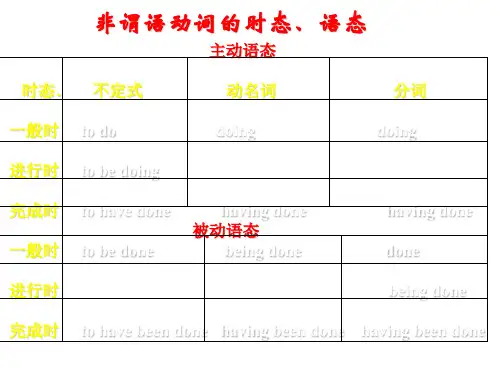
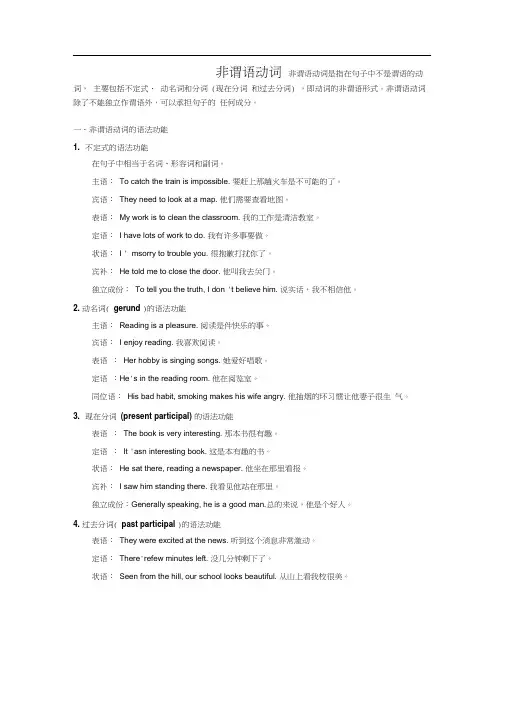
非谓语动词非谓语动词是指在句子中不是谓语的动词,主要包括不定式、动名词和分词 (现在分词和过去分词) ,即动词的非谓语形式。
非谓语动词除了不能独立作谓语外,可以承担句子的任何成分。
一.非谓语动词的语法功能1. 不定式的语法功能在句子中相当于名词、形容词和副词。
主语:To catch the train is impossible. 要赶上那趟火车是不可能的了。
宾语:They need to look at a map. 他们需要查看地图。
表语:My work is to clean the classroom. 我的工作是清洁教室。
定语:I have lots of work to do. 我有许多事要做。
状语:I ' msorry to trouble you. 很抱歉打扰你了。
宾补:He told me to close the door. 他叫我去关门。
独立成份:To tell you the truth, I don 't believe him. 说实话,我不相信他。
2. 动名词( gerund )的语法功能主语:Reading is a pleasure. 阅读是件快乐的事。
宾语:I enjoy reading. 我喜欢阅读。
表语:Her hobby is singing songs. 她爱好唱歌。
定语:He's in the reading room. 他在阅览室。
同位语:His bad habit, smoking makes his wife angry. 他抽烟的坏习惯让他妻子很生气。
3. 现在分词(present participal) 的语法功能表语:The book is very interesting. 那本书很有趣。
定语:It 'asn interesting book. 这是本有趣的书。
状语:He sat there, reading a newspaper. 他坐在那里看报。
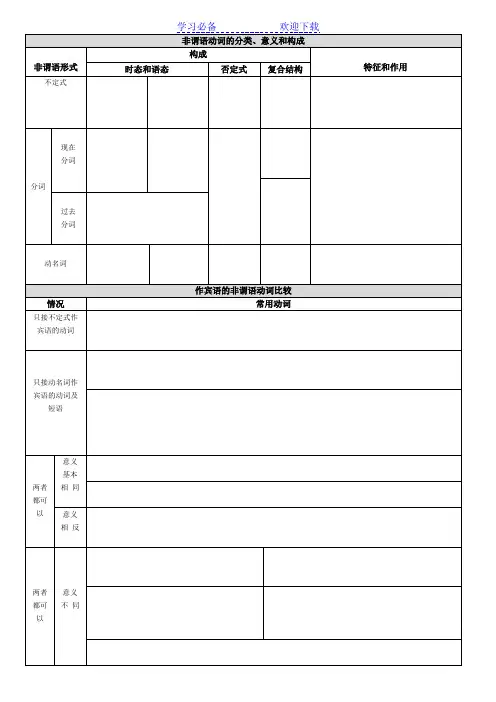
非谓语动词的分类、意义和构成非谓语形式构成特征和作用时态和语态否定式复合结构不定式分词现在分词过去分词动名词作宾语的非谓语动词比较情况常用动词只接不定式作宾语的动词只接动名词作宾语的动词及短语两者都可以意义基本相同意义相反两者都可以意义不同作宾语补足语的非谓语比较情况区别例句常接不定式作宾补的动词感官动词接非谓语形式作宾补使役动词接非谓语形式作宾补With复合结构作主语的非谓语比较情况区别例句意义不同it作形式主语的情况不同主谓一致不同作表语的非谓语比较情况区别例句意义不同My job today is _____________(water) all theflowers in the garden.My job is ____________(teach) English.Chinese is __________(interest), so Lucy isinterested in Chinese.He is ____________(fright).His speech is very encouraging.Her praise is encouraging us to work harder.The novel is well written.The novel was written by Lu Xun.作状语的非谓语比较情况区别例句不定式He stopped to have a rest.He got up early in order to/__________ catch the first train.He broke into the room,only to find an empty box. I’m pleased to meet you.It is such a good book for me as to read it three times.分词现在分词__________(walk) in the street, I came across an oldfriend of mine.(finish)his homework, the boy wentout._________(take) round the city, we were impressed bythe city’s new look._________(give) another chance, I can do it better.Tired out, they stopped to have a rest._________(laugh) and ________(talk), they went intothe classroom.The teacher came into the lab, __________(follow) bysome students.The song is sung all over the country, making it themost popular song.Judging form her accent, she must be from India.____________________(tell) many times, he stillrepeated the same mistake.过去分词独立主格结构The text finished, we began our holiday.Weather permitting, we are going to visit you tomorrow.He came out of the library, a large book under his arm. The meeting being over, we all left the room.作定语的非谓语比较情况用法例句不定式I haven’t a pen to write with.He had no money and no place to live (in).The present to be bought is for his mother.She was the first woman to win the gold medal in the Olympic Games.She is the only person to know the truth.He has no right to do it.Could you at least make an attempt to smile, Jim?I have no chance to go sightseeing.分词现在分词I don’t know the doctor __________(sit) on thechair.The building____________(build) now will be ahospital.The books________(write) by him is very popular.The professor ____________(come) hereyesterday will give us a lecture.The temple ______________________(destroy)by the earthquake will be rebuilt soon.The is the question _________(give).区别:falling leaves boiling waterfallen leaves boiled waterdeveloping countriesdeveloped countries过去分词动名词a sleeping baga walking sticka washing machine。

非谓语的9种时态表格非谓语形式一般式进行式完成式完成进行式不定式to doto be doingto have doneto have been doing- 一般式表示与谓语动作同时或之后发生。
例如:I want to go home.(同时或之后)<br> - 进行式表示与谓语动作同时进行。
例如:He seems to be reading a book. <br> - 完成式表示在谓语动作之前发生。
例如:I'm sorry to have kept you waiting. <br> - 完成进行式强调动作在谓语动作之前开始,一直持续到某个时间点且可能继续下去,较少用。
动名词doing无(本身表示动作进行)having done无- 一般式表示泛指的动作或者与谓语动作同时发生。
例如:Swimming is my favorite sport.(泛指);I enjoy reading books while having lunch.(同时)<br> - 完成式表示在谓语动作之前发生的动作。
例如:He was praised for having made great progress.现在分词doingbeing donehaving donehaving been doing- 一般式(主动)表示与谓语动作同时进行或存在的主动动作。
例如:The girl standing there is my sister.(同时进行)<br> - 一般式(被动)being done表示正在被进行的动作。
例如:The house being built is for the old. <br> - 完成式(主动)having done表示在谓语动作之前发生的主动动作。
例如:Having finished his homework, he went out to play. <br> - 完成式(被动)havingbeen done表示在谓语动作之前发生且被完成的动作。

非谓语动词的句法功能非谓语动词的形式非谓语形式构成时态和语态否定式不定式to doto be doingto have doneto be doneto have been done在非谓语前加not分词现在分词doinghaving donebeing donehaving been done 过去分词done动名词doinghaving donebeing donehaving been done1.He pretended that he was reading .He pretended ____________2. It is said that he attended the meeting yesterday.He is said _______________the meeting yesterday.3.He was in the room yesterday.He must __________in the room yesterday.4.It is said that he will be sent abroad for further study.He is said __________abroad for further study.to be reading to have attended have been to be sent名称语法功能主语宾语宾语补足语表语定语状语不定式√√√√√√现在分词√√√√√√过去分词√√√√不定式的用法最丰富,应记住一下几点:1.可以与疑问词结合在一起, 构成: 疑问词+ to do,可以代替名词性从句;2.常与形容词结合在一起,构成: 形容词+ to do;3.有丰富的句型。
1.It is very kind of you to help me.= You are kind to help me.2.The old needs / wants / requires sending to hospital. = The old needs / wants / requires to be sent to hospital.3.They lifted a rock only to drop in their own feet.4.The stone is too heavy to lift.5.He is strong enough to lift the stone.6.The clothes are easy to wash.= It is easy to wash the clothes.= The clothes wash easily.7. I need some paper to write on.8. He is always the first to get to school and the last to go home.9.Why not go with me?10.You can take a bus if you want to11. I don’t know what to do.12.I had intended to see you, but I have no time.= I intended to have seen you, but I have no time.13.It is said that he went there yesterday.= He is said to have gone there yesterday.14.To see is to believe= Seeing is believing.15.I was about to go out when I met my mother.作主语to dodoing for sb.+ to dosb's + doing (For us) to go there is important.It is important (for us) to go there.His coming surprised us.It's no use/no good/useless/hard talking with him.Smiling is good for health.区别?逻辑主语动作发生时间所指的对象信息来源to do确定未发生,将来特定具体新的doing不确定现在,过去,进行抽象泛指旧的,经验to do与doing的区别非谓语动词的用法主要指在句中所作的成分作宾语介词+ doing 熟记接doingmiss mind enjoy 小姐(错过)介意享受(喜欢),admit suggest advise承认建议劝告,avoid imagine risk避免想象冒险,stop/give up delay escape 停止拖延逃跑,consider practise finish考虑实践完成,include excuse/forgive bear/stand 包括原谅忍受“动词+非谓语动词作宾语”的各种情况1.见上表2.want, wish, hope, decide, learn, would like, plan3.love, like, hate, prefer, begin, start, continue, intend, attempt4.stop, try, mean, regret, remember, forget, need/want/require, go on 1. 动词+doing;2. 动词+to do;3. 动词+to do 和doing ,意思没什么改变;4. 动词+to do 和doing ,意思改变很大。
非谓语动词的时态与语态在英语语法中,非谓语动词是指不带有主语和谓语关系的动词形式。
它们包括动词不定式、动名词和分词。
而非谓语动词的时态和语态往往是我们学习过程中容易混淆的地方。
本文将针对非谓语动词的时态和语态进行探讨,帮助读者更好地理解和运用。
一、动词不定式时态与语态动词不定式是主动形式和被动形式一致的,无人称和数的变化。
即使在被动句中,不定式的形式也保持不变。
例如:- 主动形式:to eat(吃)- 被动形式:to be eaten(被吃)动词不定式没有时态的变化,所以它常常用来表示和主句谓语动词同时或者稍晚发生的动作。
例如:- I hope to see you tomorrow.(我希望明天见到你。
)- She promises to help me with my homework tonight.(她答应今天晚上帮我做作业。
)此外,动词不定式还可以用来表示含义上的将来、远将来以及可能发生的动作。
例如:- He plans to travel to Europe next year.(他计划明年去欧洲旅行。
)- I hope to win the lottery someday.(我希望有一天中彩票。
)二、动名词时态与语态动名词在时态和语态上与现在分词相同。
例如:- 主动形式:singing(唱歌)- 被动形式:being sung(被唱)相对于动词不定式,动名词可以表示更早的动作。
例如:- After finishing her work, she went home.(她把工作完成后,回家了。
)- He admitted stealing the money.(他承认偷了那笔钱。
)动名词也可以表示同时进行的动作或者是取决于主句谓语动词发生的动作。
例如:- I love swimming in the ocean.(我喜欢在海里游泳。
)- He enjoys listening to music while studying.(他喜欢一边学习一边听音乐。
非谓语动词的时态和语态
非谓语动词不具有时态和语态。
非谓语动词包括动词不定式、动名词和分词(包括现在分词和过去分词)。
它们不受主语的人称和数的影响,也不受谓语动词的时态和语态的限制。
例如:
- 动词不定式:to eat(吃)
- 现在时:I like to eat fruit.(我喜欢吃水果。
)
- 过去时:He wanted to eat dinner.(他想吃晚饭。
)- 动名词:eating(吃)
- 现在时:I enjoy eating ice cream.(我喜欢吃冰淇淋。
)
- 过去时:She remembered eating lunch at the restaurant.(她记得在餐厅吃午饭。
)
- 现在分词:eating(吃)
- 主动语态:I saw a man eating an apple.(我看到一个人在吃苹果。
)
- 被动语态:The cake being eaten was delicious.(被吃掉的蛋糕很好吃。
)
- 过去分词:eaten(吃)
- 主动语态:He has eaten breakfast.(他已经吃过早饭了。
) - 被动语态:The cake eaten by him was tasty.(被他吃掉的蛋糕很好吃。
)。
非谓语动词一、不定式动词不定式有两种形式:带to的动词不定式“to+动词原形”和无to的动词不定式“动词原形”。
动词不定式不能单独作谓语,它没有人称、数的变化,但有时态和语态的变化。
它(知识补足:动词不定式的否定式在不定式“to”前加“not”)(一)动词不定式的句法功能不定式在句中可以作主语、表语、宾语、宾语补足语、定语、状语。
1、作主语(1)表示较具体的一次性的或带有将来意味的动作。
例:To learn a foreign language is not easy. 学习外语不是一件容易的事。
(2)作主语时,如果其后的表语为动词,通常也用不定式作表语。
例:To go to the palace without jewellery is to say “I’m poor”.不戴珠宝去宫廷就是在说:“我很穷”。
(3)作主语时,常用it作形式主语,而将不定式放到谓语之后。
例:It’s a great honor to be invited to Mary’s birthday party.很荣幸被邀请参加玛丽的生日聚会。
(4) for sb的句型表示事物的特征、特点,常用来表示客观属性的形容词。
Easy,difficult,interesting,important,impossible,necessary例:It is difficult for the students to read the book. 学生们读这本书有点难。
of sb的句型表示人物的性格、品德,常用表示主观感情或态度的形容词。
careful,clever,cruel,kind,nice,rude粗鲁的,silly愚蠢的,wrong,careless例:It is careless of him to break the cup.他太粗心了,把杯子打破了。
2、作表语(1)不定式作表语时,一般紧跟在系动词后,说明主语的内容。
例:The great happiness is to serve the people. 最大的幸福就是为人民服务。